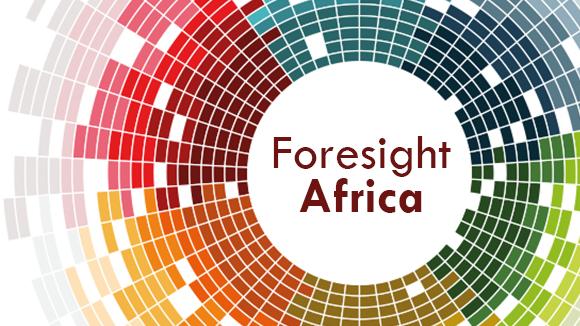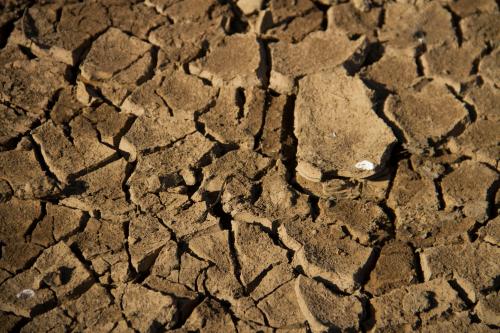Below is a viewpoint from the Foresight Africa 2022 report, which explores top priorities for the region in the coming year. Read the full chapter on climate change.
 The impact of climate change on Nigeria’s environmental and socioeconomic systems is compounding the country’s fragility risks. Extreme weather patterns—fiercer, longer dry seasons and shorter, more intense rainy seasons—are exacerbating challenges confronting local communities. Extensive cultivation and overgrazing have been compounded by desertification, rendering large swaths of land in northern Nigeria unproductive. Unpredictable and higher-intensity rainfall in southern Nigeria is resulting in a loss of crops and the displacement of communities. Depleting environmental resources in every part of the country pose a serious food security challenge in the face of a rapidly growing population. In fact, the 2021 Notre Dame Global Adaptation Index ranks Nigeria as the 53rd most-vulnerable country and the 6th least-ready country in the world to adapt to climate change.
The impact of climate change on Nigeria’s environmental and socioeconomic systems is compounding the country’s fragility risks. Extreme weather patterns—fiercer, longer dry seasons and shorter, more intense rainy seasons—are exacerbating challenges confronting local communities. Extensive cultivation and overgrazing have been compounded by desertification, rendering large swaths of land in northern Nigeria unproductive. Unpredictable and higher-intensity rainfall in southern Nigeria is resulting in a loss of crops and the displacement of communities. Depleting environmental resources in every part of the country pose a serious food security challenge in the face of a rapidly growing population. In fact, the 2021 Notre Dame Global Adaptation Index ranks Nigeria as the 53rd most-vulnerable country and the 6th least-ready country in the world to adapt to climate change.
As a result, growing desperation over food supply is driving resource conflicts across Nigeria. In short, farmer/herder violence over the past decade has worsened and disrupted business operations across the country. Urgent action is needed to improve food and economic resilience to prevent deeper crises.
Poor governance and stakeholder engagement remain the greatest challenges to climate resilience in Nigeria.
The COVID-19 pandemic compounded Nigeria’s food security and inequality challenges. Although spared the worst of the public health impact, the nation’s lockdown, imposed to contain spread of the virus, disrupted food production and hit household incomes hard. In fact, only 50 percent of agricultural workers in Nigeria were able to work through April and May 2020—two critical months during the planting season for Nigeria’s predominantly rain-fed agriculture. By August 2020, an estimated 70 percent of households in Nigeria reported medium to severe food insecurity. Over 67 percent reported that their total income decreased compared to August 2019.
Poor governance and stakeholder engagement remain the greatest challenges to climate resilience in Nigeria. Although awareness and understanding of the impacts of climate change are growing among key stakeholders, the government has been unable to galvanize effective collective action for mitigation and resilience.
Policy recommendations
The underlying pressures that are compounding Nigeria’s climate resilience situation can only be eased over the long term. But collective effort must start now.
The National Adaptation Plan (NAP) published by the Federal Ministry of Environment in June 2020 articulates a framework for different sectors of the economy to work together to address Nigeria’s climate challenges. It proposes a sectoral governance approach and defines specific roles and responsibilities for private sector, civil society, and national and subnational governments. It also seeks to align other existing economic, national development, and climate resilience policies with the country’s climate goals.
Reducing food and nutrition vulnerability, while enhancing environmental resilience is perhaps Nigeria’s most critical climate adaptation objective. The National Agricultural Resilience Framework (NARF) provides an excellent policy platform to achieve this goal. The National Livestock Transformation Plan (NLTP) can also help address farmer-herder conflict by creating mutually beneficial relationships and reducing the need for harmful competition between these two critical stakeholder groups.
Although Nigeria has 2.6 percent of the world’s population, it is only responsible for 0.26 percent of global emissions.
Although Nigeria has 2.6 percent of the world’s population, it is only responsible for 0.26 percent of global emissions. Importantly, though, reducing emissions in the energy sector can protect Nigeria’s rapidly depleting tree cover and improve the quality of life for millions of citizens. Indeed, the National Energy Transition Plan announced by President Muhammadu Buhari at COP26 in Glasgow promises to improve energy access to over 25 million Nigerian homes while reducing dependence on fuel wood.
Developing and announcing these policies represent a good start, but the government needs to translate its published objectives into diligent action. The Nigerian Federal Government must deepen consensus around its Nationally Determined Commitments and galvanize implementation programs that are inclusive of women, youth, and marginalized communities. These groups have significant roles to play in decreasing population pressure, reducing energy poverty, and improving productivity of food value chains.
In the end, Nigeria will require the assistance of the international community to successfully manage its climate fragility risks. With a population projected to balloon to 400 million by 2050, the stakes are high not only for Nigeria, but for the continent and rest of the world.
The Brookings Institution is committed to quality, independence, and impact.
We are supported by a diverse array of funders. In line with our values and policies, each Brookings publication represents the sole views of its author(s).








Commentary
Managing existential risk and climate resilience: The case of Nigeria
March 14, 2022